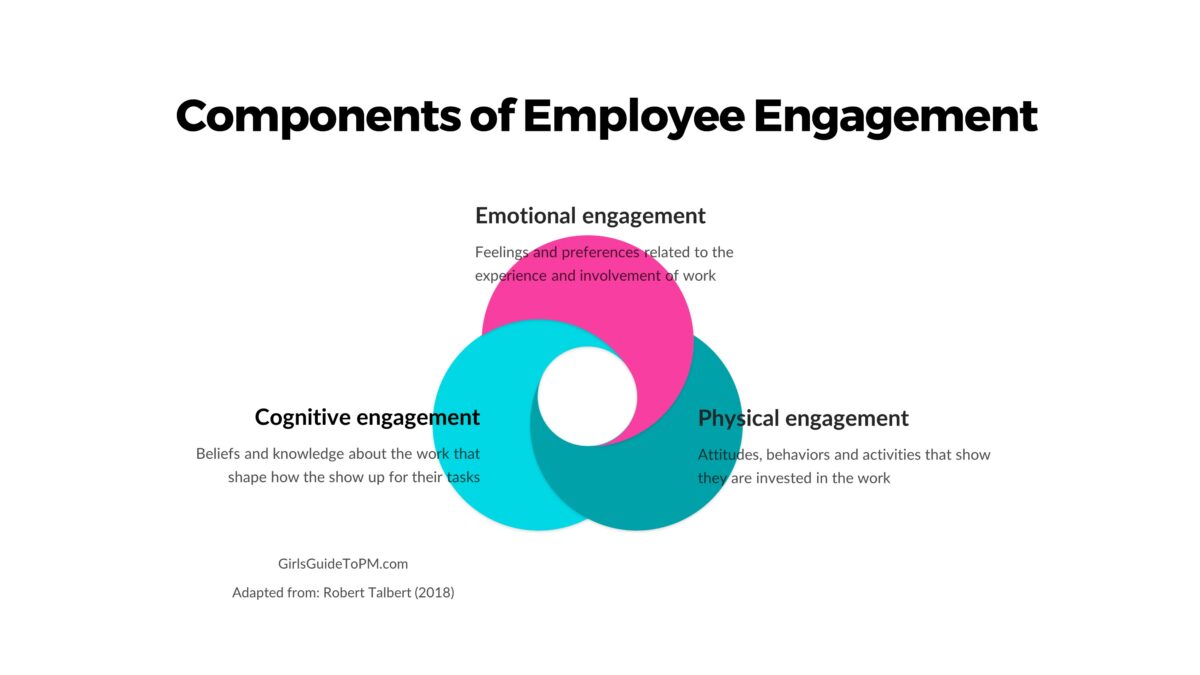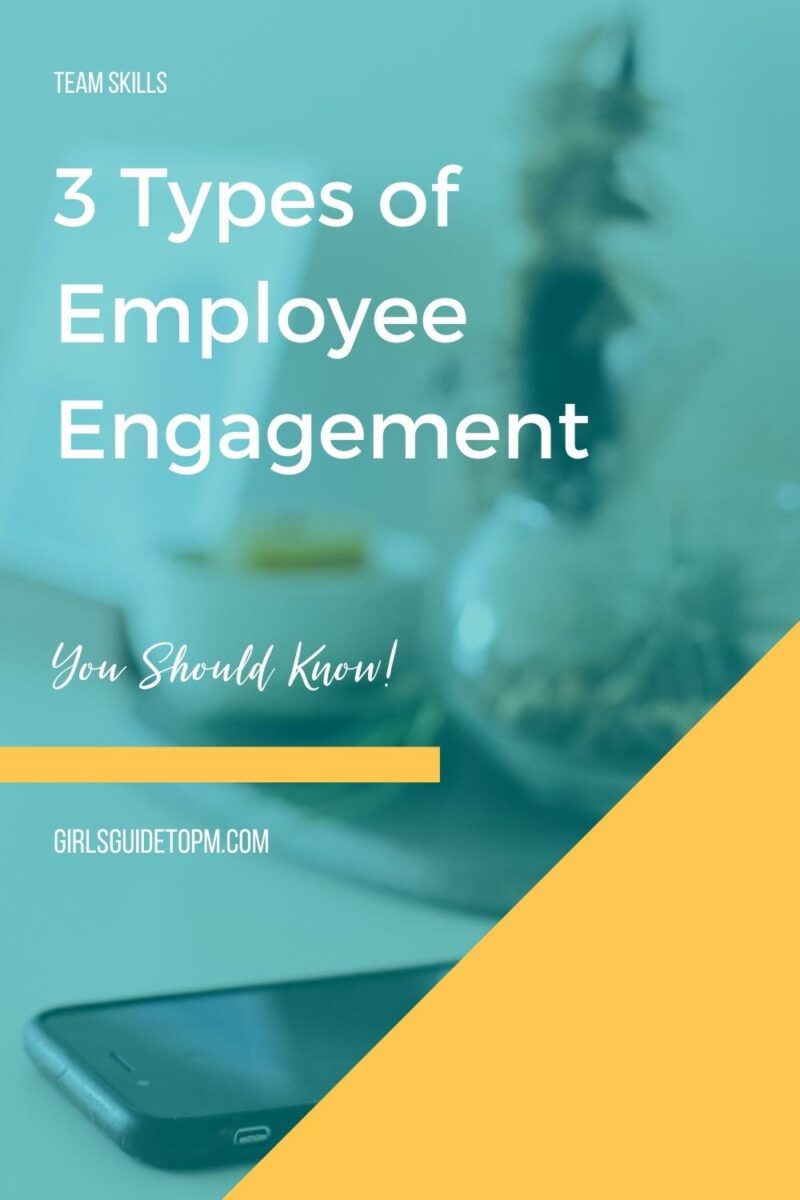The 3 Types Of Employee Engagement You Should Know
This is a guest post by Matt Diggity.
Wouldn’t it be great if project team members were engaged with their work, leapt at the opportunity to hit their milestones and proactively progressed their tasks without you having to chase them?
If leading your team feels like you need to constantly prod them to get stuff done, perhaps you have an employee engagement problem.
In this article, we’ll give you the 3 types of engagement you need to focus on to build an environment where everyone wants to work and the whole team is committed to delivering the project.

What is employee engagement?
Employee engagement is a hot subject among business executives. It’s described as an employee’s emotional connection to their employer.
When an employee is fully engaged with their employer, they are highly motivated to go above and beyond what is required of them – and that’s exactly what we need on project teams, right?
In organizations, employee engagement improves workplace morale and encourages employees to buy into the leadership’s overall goals, priorities, and strategy. The more an organization interacts with its workers, the more invested they become in its success.
Why is employee engagement important?
Employee motivation is a fundamental factor in improving productivity. Employees who are engaged take a holistic view of the organization and understand their position, where they fit in, and how their actions contribute to its success.
As a result, they are able to make better decisions and have more self-ownership over their actions.
Companies that have a highly motivated and engaged workforce outperform their competitors with less engaged employees. They bounce back faster from recessions and financial setbacks and are able to develop new products or services at a higher rate.
According to Gallup, just 39% of Americans are engaged in their careers, while 14% claim to be “actively disengaged.” Although these figures have changed over time (and during 2020 it seems like they were all over the place), there is still much room for improvement in terms of employee engagement.
Activities, sports, and festivals aren’t the only ways to keep employees engaged. People have different reasons for coming to work, and a truly effective employee engagement program will take care of different facets of their employees’ needs.
Lots of work has been done on the concept of engagement and what goes into it. The literature review by Dr Robert Talbert is a good place to start if you want to read more. A lot of the analysis has been done on engagement in education, but we can adapt the same ideas to the workplace, so let’s do that.
Employee engagement strategies can be classified into three categories based on their desired end results:
- Cognitive engagement: Employees are focused and committed to their job
- Physical engagement: Their attitudes and activities show that they are invested in the work
- Emotional engagement: They channel their feelings and emotions into their work.

Let’s discuss the three types of employee engagement in more detail.
1. Cognitive engagement
Cognitive engagement means that employees are aware of and engaged with the organization’s overall plans and know what they need to achieve the best possible return on their job efforts.
Employees must understand their employer’s vision and strategies to be fully engaged at this stage. They should also know what they must achieve to contribute as much as possible to the organization.
People who are passionate about their jobs and have more experience are more creative and make more confident decisions.
Let’s imagine that you run a digital marketing firm that helps other companies stand out from their competition and get the best results. You have skilled, experienced employees who are thoroughly knowledgeable about how to run projects, different types of digital marketing, their advantages, different software to use and leading a team to get the work done.
Your team needs to have specific goals and strategies when engaging with clients and projects.
This is why you need a vibrant community, and a creative workplace needs a diverse range of thought habits and interests. People with diverse viewpoints can spot risks and opportunities that others might overlook.
According to one report, cognitive diversity can boost team creativity by up to 20% while also lowering risk-taking by up to 30%. Another study discovered that teams with more cognitive diversity tackle problems faster.
2. Physical engagement
Employees who are physically engaged devote their emotional and physical energy to their work. People with a lot of energy have better overall health, which allows them to contribute more to the business.
To get the most out of its workforce, a business needs to ensure that its employees are physically and mentally healthy.
This has become even more important with the ongoing public health crisis. Many companies don’t just offer medical and dental coverage for their employees. Many also offer mental health services to those who need support.
A healthy, active workforce is one that is also productive and creative. This does not just apply to industries that place heavy physical demands on their workers, such as construction and engineering; it also applies to other labor-intensive industries, such as education and retail.
3. Emotional engagement
Employees’ emotional commitment refers to their sense of belonging and confidence in the organization and its members. Emotional engagement is based on the process of managing one’s emotions while at work.
People who are emotionally involved in their jobs are more likely to feel good or happy about it, and experiencing such a positive effect gives them a sense of accomplishment and satisfaction for a job well done.
For example, if a project manager is able to lead multiple projects successfully at the same time, they become justifiably proud of their achievement. They also earn their colleagues’ respect as they’ve shown what they could bring to the company.
When a leader has a positive outlook on their life and career, this attitude tends to infect their colleagues and people reporting to them. On the other hand, a manager that exhibits a high degree of negativity is bound to influence other people the same way.
Sometimes, individuals just feel tired and overwhelmed with everything they need to finish. This has been more pronounced in the past year, especially where there are very few chances to interact with friends and colleagues in person.
Companies that offer remote mental health and coaching sessions enjoy higher engagement rates. Thanks to webinar platforms, companies can do just that with ease.
Looking after your most valuable asset
Employee engagement is an ongoing organizational initiative that requires a long-term vision in business strategy to increase employee efficiency and retention rates. A company’s most valuable asset is its workers. However, this is only true when the workforce is productive.
Any successful employee engagement program takes care of the three pillars of engagement: cognitive engagement, physical engagement, and emotional engagement. Each of these facets of engagement has its own roles to play in ensuring that the workforce performs as expected or better.
Every meaningful attempt to evaluate employee/workplace problems, regardless of strategy, must consider what the employees need and find a common ground with business requirements.
As long as employees feel that their workplace is taking care of them, they will stay strong, healthy, productive, and creative, and make more impact on their projects.

Pin for later reading

